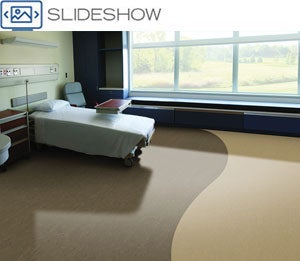Earth-friendly flooring for health care facilities

Click here for a slideshow.
Health care organizations are taking a holistic view that considers their responsibility to people, the planet and profits — known as the three pillars of sustainability — when choosing interior design materials, and that includes flooring.
Tim Cole, vice president of marketing for flooring manufacturer nora Systems Inc., whose U.S. headquarters is in Salem, N.H., says, “The viewpoint from health care facilities is, ‘What is a specific attribute that is going to bring value to my facility as well as make a positive impact from a human health perspective?’”
Specific attributes of flooring that affect the health and safety of patients, visitors and staff include the material’s contribution to indoor-air quality; its slip-resistance, acoustic and ergonomic properties; and its capacity to be maintained through green cleaning methods. Life-cycle cost also is important to health facilities. In addition, many flooring companies are addressing and voluntarily disclosing the total environmental impact of their products.
“We like to try to do our best in bringing a balance between making sure that we are looking at the construction of our product and the impact from an overall environmental footprint but, at the same time, making sure that we address the sustainable attributes that we know our customers in health care are so concerned about,” Cole says.
Materials lead the way
At nora, this begins with raw materials, according to Cole. Approximately 60 percent of the materials used to manufacture nora floors are locally sourced, he says. Materials in nora flooring include natural and industrial rubber, raw minerals and environmentally friendly pigments.
These floors require no finishing, waxing or sealing, which eliminates the need for harsh cleaning chemicals. The specially designed scrubbing pads of the nora pro clean system are made to clean the floors simply with water.
You may also like |
| Hard flooring options for health facilities |
| Developing a hospital floor cleaning program |
| Floor cleaning equipment for health care settings |
|
|
The company’s new noraplan valua product was developed to meet the needs of clients seeking a more natural look for areas like patient rooms and the public spaces of health facilities. The valua product is slightly embossed to give it texture and detail inspired by nature. It is available in sheets and tiles and a wide range of colors. The flooring is designed for high-performance acoustics, ergonomics and slip-resistance and is certified to be low volatile organic compound (VOC)-emitting.
Transparency about the environmental impact of its products is important to nora, Cole says. The company is a member of the U.S. Green Building Council and its products hold certifications from a number of organizations like the Greenguard Environmental Institute. Recycled and recyclable packaging and efficient freight transport are among the other environmental initiatives being undertaken by nora. A new global sustainability strategy is under development at the company. Cole says that while nora has always had a commitment to sustainability, this new strategy, which likely will be ready for implementation at the beginning of 2017, will “raise the bar up to the next level for what we can do to answer the demands for sustainability in the market.”
Standing under pressure
Ridley Kinsey, director of health care and retail markets for Patcraft, Cartersville, Ga., a commercial flooring brand of Berkshire Hathaway subsidiary Shaw Industries Group Inc., says that when he’s recently asked designers what sustainability means to health care interiors, a common reply has been, “durability.”
“That’s a really good answer,” he says. “If you have flooring that’s really durable, that means it’s going to last a long time.” This results in lower life-cycle costs, easier maintenance, less landfill waste and fewer resources used in manufacturing. For this reason, “we focus first on performance,” Kinsey says.
The negatively charged fiber of Patcraft’s Solution Q Extreme yarn is designed to repel acid-based stains like coffee or juice, so they can be removed with water only. According to the company, its EcoWorx carpet tile backing has five times the tensile strength and eight times the tear strength of traditional PVC-backed tiles. EcoWorx backing is standard for Patcraft carpet tile, and it is available for broadloom and performance broadloom products to create a moisture barrier. EcoWorx is under development for use with resilient flooring, too. The material comes with a guarantee that the company will reclaim and recycle it at the end of its useful life. Shaw Industries has a number of recycling plants, including a $20 million facility that opened last year in Ringgold, Ga., that can recycle both polyester and nylon carpet.
Patcraft’s high-performance Butterfly Effect collection features both EcoWorx backing and Solution Q Extreme yarn. The patterns of this collection are inspired by butterfly wings. Two percent of sales of Butterfly Effect products are being donated to St. Jude Children’s Research Hospital.
This collection was designed in collaboration with William McDonough, founder of the Cradle to Cradle Products Innovation Institute, which certifies products for safe material use and reutilization. “We’ve been involved with [Cradle to Cradle] since the outset,” says Kinsey. The company works with other third-party groups, as well, to certify the environmental health of its materials. For example, many Patcraft products are compliant with the International Living Future Institute’s Living Building Challenge "red list," a list of materials the organization says should be phased out of production because of health concerns.
Patcraft offers sustainable adhesives in addition to sustainable flooring. LokDots pressure-sensitive adhesive is an odorless product for installing carpet tile that can be walked on almost immediately after installation. The company offers a water-based spray adhesive for resilient flooring that has the same qualities. These installation systems use fewer chemicals, create less odor and require less downtime than conventional adhesives.
Safe, clean, comfortable
As part of an approach called “Committed to the Health of One,” the flooring group at Forbo International, whose U.S. headquarters is located in Hazleton, Pa., is “trying to offer solutions that create an environment that is safe, hygienic and comfortable to be in,” says Willem Burmanje, director, strategic marketing and communications.
The company’s linoleum flooring fits this model: It is manufactured of natural ingredients (linseed oil, rosin, wood flour and limestone), is nonslip, low VOC-emitting, naturally bacteriostatic, easy to clean, and has a high light-reflection value, which can enhance the level of natural light in the patient environment. Given these qualities, Forbo’s Marmoleum brand linoleum “is the perfect floor covering for health care,” says Burmanje.
According to Burmanje, Marmoleum was the first product in the industry to be given a complete life-cycle assessment (LCA) to measure its total environmental impact. LCAs are now part of Forbo flooring’s product development cycle.
“Every time we make a new range or we renew a range, one of the criteria is that we have to score better on LCAs — we have to have a better environmental profile. If not, we will not launch that product,” says Burmanje. “We’re not only talking about color and design, but also about the way that we make the product, the way the product performs and, in particular, its environmental performance,” he explains. The company has published Environmental Product Declarations (EPDs), registered documents that quantify the total environmental impact of a product, for its entire product line.
Ecore, Lancaster, Pa., has completed EPDs for several of its products, including Terrain rx, 2015 Gold award winner in the resilient flooring category of the Nightingale Awards, which recognize innovative product designs for health care environments.
Terrain rx features a 5 mm layer of recycled rubber backing fusion-bonded to a heterogeneous sheet vinyl surface. It is designed to reduce injuries from falls, provide a comfortable walking and standing surface and deliver sound control equal to that of carpet. “The product delivers beyond the norm,” says Mark Huxta, director of health care sales, Ecore. “The whole conversation that we have now when it comes to health care flooring is just at a different level than what I think people are accustomed to.”
According to the company, Ecore reuses more than 75 million pounds of scrap tire rubber each year as material for its flooring products, which is equivalent to conserving 1 million barrels of oil or keeping 2,000 trailer loads of discarded tires out of landfills. To further reduce landfill waste, Ecore reclaims its flooring products at the end of their useful lives and recycles them into new flooring, underlayments or industrial products through a program it calls Redeux. Other forms of postconsumer waste, such as retired running shoes and old tennis balls, are accepted by the company for reclamation, as well. “We’ve always believed that sustainability is achieved when waste is your raw material,” says Bo Barber, the company’s vice president of sales and strategic business development.
Tom Burns, health care and pharmaceutical market manager for the Stonhard Group, Maple Shade, N.J., says health facilities can gain significant environmental and financial benefits through sustainability initiatives in flooring. “These initiatives contribute to a healthier environment, improve the patient’s experience and improve the community’s perception of the facility,” he says.
The company has removed lead- and chromium-based pigments from products to avoid health hazards associated with these compounds. In addition, Stonhard reports that 90 percent of its new product development and reformulation efforts are directed toward water-based urethanes or solid epoxy-based chemistry, to provide safer floor and coating products and reduce hazardous waste.
Stonhard epoxy and urethane flooring products like Stonblend GSI-G, Stonclad GR-G and Stonclad G2 are manufactured with rapidly renewable and recycled materials. Because the company’s flooring is made to stand the test of time, it doesn’t end up in a landfill itself, Burns says. Also, less maintenance enables health care facilities to focus more on the people they serve.
“We committed decades ago to provide our health care customers with products and services that are truly green,” Burns says. “These green products help to lower operational costs, which allows hospitals to direct more resources to patient care.”
For more information
The following companies were mentioned in the article:
• Ecore: http://ecorecommercialflooring.com/
• Forbo International: http://www.forbo.com/flooring/en-gl/
• nora Systems Inc.: http://www.nora.com/us/
• Patcraft: http://www.patcraft.com/
• The Stonhard Group: http://www.stonhard.com/




